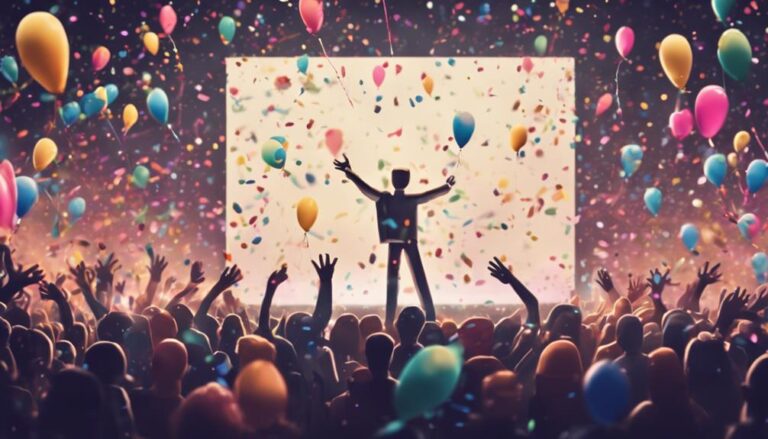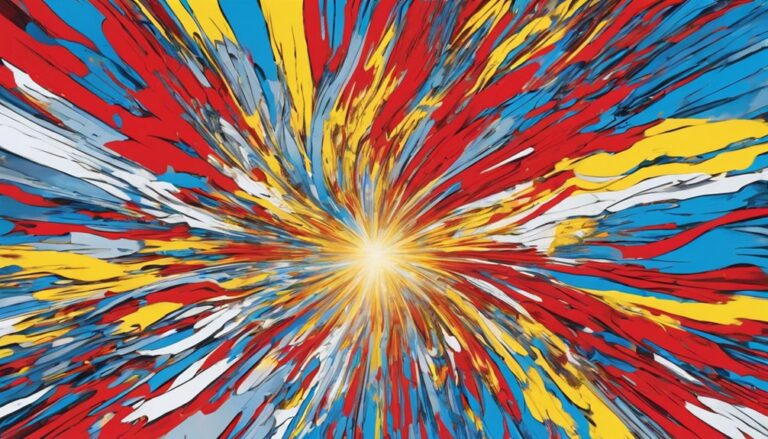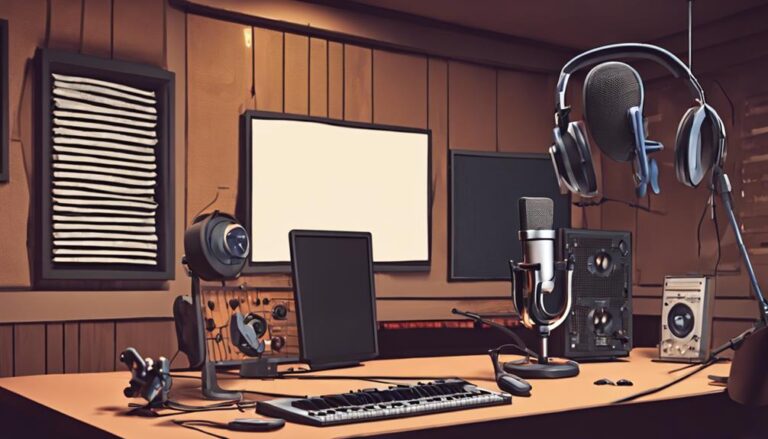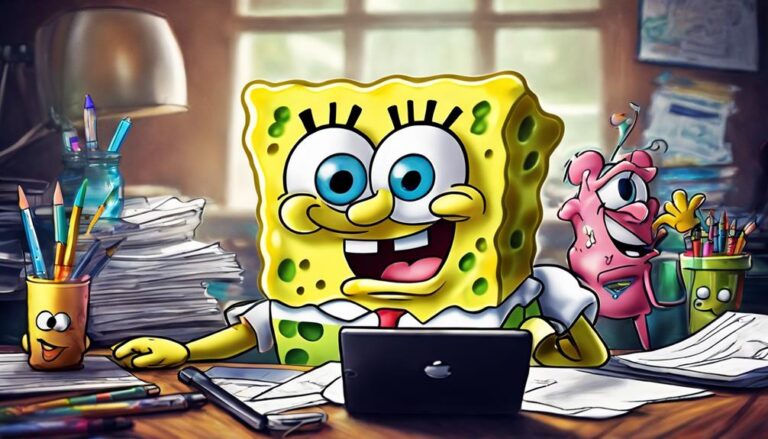What Drives Innovative Animation Designs
As you venture into the world of innovative animation designs, you're driven by the fusion of artistic vision, cutting-edge technology, and cultural influences. Your imagination is sparked by emerging technologies like Virtual Reality, Artificial Intelligence, and game engines, which enable immersive experiences and stunning visuals. Crafting relatable characters and transporting viewers into animated worlds through emotive storytelling fuels your passion. You're also influenced by artistic global exchange, cross-cultural fusions, and international inspirations that shape the world of animation. With this foundation, you're poised to unlock new creative possibilities and push the boundaries of what's possible in animation design.
Key Takeaways
- Artistic vision, fueled by passion for storytelling and visual expression, drives innovation in animation design.
- A balance between artistic freedom and creative constraints enables pushing boundaries while refining the artistic vision.
- Technical precision is crucial in bringing artistic vision to life and making innovative designs a reality.
- Collaboration and feedback from cross-discipline brainstorming sessions drive the fusion of creative possibilities forward.
- Emerging technologies like AI, VR, and game engines enable stunning visuals, immersive experiences, and interactive environments that blur reality and fantasy.
The Role of Artistic Vision
As you delve into the world of innovative animation designs, the role of artistic vision becomes the north star that guides your creative journey.
It's the spark that ignites the flame of imagination, fueling your passion for storytelling and visual expression. Artistic freedom is the lifeblood of innovative animation, allowing you to push boundaries and challenge conventional norms.
But with great freedom comes great responsibility, and it's the creative constraints that help shape and refine your vision.
The tension between artistic freedom and creative constraints is what drives innovation in animation design.
By working within established parameters, you're forced to think outside the box and find novel solutions to complex problems. This delicate balance between creative expression and technical precision is what sets truly innovative animation designs apart from the rest.
As you navigate this dynamic interplay, you'll discover new ways to bring your artistic vision to life, crafting stories that captivate and inspire audiences worldwide.
Emerging Technology Trends
With the power of artistic vision at your fingertips, you're now poised to harness the limitless potential of emerging technology trends in innovative animation designs.
One of the most exciting trends is Virtual Reality (VR) which allows you to transport your audience into immersive, interactive environments that blur the lines between reality and fantasy.
Imagine creating an animation that lets viewers walk alongside characters, feel the rush of the action, and even influence the narrative.
Artificial Intelligence (AI) is another game-changer, enabling you to automate repetitive tasks, generate new ideas, and even collaborate with AI-powered tools to create stunning visuals.
AI can help you analyze vast amounts of data, identify patterns, and develop animations that are tailored to specific audiences.
As AI technology advances, you'll be able to push the boundaries of animation even further, creating complex, realistic characters and environments that respond to viewer interactions in real-time.
Storytelling in Animation
As you bring your animated story to life, you're crafting a symphony of emotions, visuals, and pacing to captivate your audience – and that's where emotive character development comes in, making your characters relatable and authentic.
You'll also incorporate visual story elements that transport viewers into your world, from meticulously designed sets to nuanced lighting schemes.
Emotive Character Development
Imagine stepping into the shoes of a character who's just experienced a heart-wrenching loss.
You see the world through their eyes, feeling their emotions, their pain, and their struggle to cope.
As an animator, creating characters that evoke emotions in your audience is crucial for emotive character development.
You want your viewers to invest in the character's story, to care about their journey and root for their success.
To achieve this, you need to craft character arcs that resonate with your audience.
A character arc is the transformation a character undergoes throughout the story.
It's the growth, the change, and the lessons learned.
Here are some key elements to consider:
- Develop a rich backstory to inform your character's motivations and actions.
- Create nuanced dialogue that reveals character traits and emotions.
- Use body language and facial expressions to convey emotions and personality.
- Make your character relatable, flawed, and likable.
Visual Story Elements
Crafting a compelling narrative in animation requires more than just well-developed characters – it demands a rich tapestry of visual elements that bring the story to life.
You'll need to carefully consider the use of color scripts, which outline the palette and tone of each scene, to evoke the desired emotional response from your audience. A color script can transform a mundane setting into a vibrant world that immerses viewers in the story.
Visual metaphors are another powerful tool at your disposal.
By using abstract or symbolic imagery, you can convey complex themes and emotions without resorting to heavy-handed exposition. For example, a character's inner turmoil might be represented by a swirling storm cloud, while their growth and transformation could be symbolized by a blossoming flower.
By incorporating these visual elements, you'll create a narrative that engages your audience on multiple levels. As you weave these threads together, your story will take on a depth and richness that captivates and inspires your viewers.
The key is to balance these elements in a way that feels organic and authentic, allowing your audience to become fully invested in your world.
Narrative Pacing Techniques
Effective narrative pacing techniques are the backbone of engaging storytelling in animation.
They enable you to control the flow of your story, creating a captivating experience for your audience.
By manipulating time and space, you can build tension, create suspense, and evoke emotions in your viewers.
To achieve this, consider the following techniques:
- Time compression: Use quick cuts and fast-paced editing to convey a sense of urgency or excitement. This technique is particularly effective in action sequences or dramatic moments.
- Montage editing: Combine a series of short shots to convey a longer period of time. This technique is ideal for showing character development or a passage of time.
- Slow motion: Use slow motion to emphasize important moments or create a sense of drama. This technique can add emotional depth to your story.
- Cross-cutting: Interweave two or more storylines to create a sense of tension or suspense. This technique can keep your audience engaged and invested in your story.
Cultural and Social Influences
As you explore the realm of innovative animation designs, you're likely to notice a rich tapestry of artistic global exchange, where animators from diverse backgrounds weave their unique cultural perspectives into mesmerizing visual narratives.
You see, this exchange isn't just about borrowing styles – it's about fusing traditions and pushing the boundaries of storytelling.
Artistic Global Exchange
Imagine yourself strolling through the vibrant streets of Tokyo, where neon-lit anime billboards tower above traditional temples, or walking through the colorful streets of Rio de Janeiro, where Carnival-inspired murals blend with cutting-edge street art.
As you soak in the rich cultural heritage of these cities, you begin to realize the profound impact of artistic global exchange on innovative animation designs.
Cross-cultural fusions and international inspirations are increasingly shaping the world of animation, as artists and designers collaborate across geographical boundaries to create something entirely new.
- Japanese anime's influence on Western animation, as seen in the likes of "Avatar: The Last Airbender" and "Korra".
- The incorporation of African and Afro-Brazilian cultural elements in Disney's "The Lion King" and "Moana".
- The fusion of traditional Indian and modern digital art in the animation of "The Jungle Book" (2016).
- The use of Latin American folklore in Pixar's "The Book of Life".
As you explore the diverse cultural landscapes of the world, you'll find that artistic global exchange is driving innovative animation designs that are more vibrant, eclectic, and captivating than ever before.
Diverse Social Values
One of the most profound ways artistic global exchange shapes innovative animation designs is by integrating diverse social values.
When you combine the perspectives of different cultures, you get a rich tapestry of stories, ideas, and experiences that can inspire fresh animation styles. By embracing cultural norms from around the world, animators can break free from traditional storytelling approaches and create unique narratives that resonate with diverse audiences.
You can see this in the way anime often incorporates elements of Japanese culture, such as vibrant colors and dynamic character designs, to create a distinct visual identity.
Similarly, Latin American animation frequently celebrates the region's vibrant cultural heritage, from the rhythms of salsa music to the vibrant hues of Carnival costumes.
By embracing diverse social values, animators can also explore complex themes related to personal identity, such as social justice, self-discovery, and community.
As a result, innovative animation designs that reflect the diversity of human experience can emerge, captivating viewers worldwide with their authenticity and emotional depth.
Experimental Techniques Used
When you dive into the world of innovative animation, you'll find that experimental techniques are being pushed to new boundaries.
Digital pioneers are now combining their expertise with analog roots, resulting in unique visual effects and storytelling methods.
As a result, you'll notice a blend of traditional and modern techniques in the production of innovative animations.
Some of the experimental techniques used in innovative animation include:
- Mixed media collage: combining traditional art with digital elements to create visually striking and textured scenes
- Generative art: using algorithms and mathematical formulas to create unique, dynamic patterns and shapes
- Stop-motion manipulation: using traditional stop-motion techniques, but with a twist, such as using unusual materials or manipulating the environment
- Virtual reality storytelling: using VR technology to immerse viewers in the story, creating a more interactive and engaging experience
These experimental techniques allow animators to push the boundaries of storytelling and create innovative, visually stunning animations that captivate audiences worldwide.
Collaboration and Feedback
You're witnessing the fusion of innovative techniques and artistic vision in the world of animation.
As you delve deeper, you notice the vital role collaboration and feedback play in driving this fusion forward. When animators, writers, and directors come together, they unlock a wealth of creative possibilities.
Cross-discipline brainstorming sessions spark new ideas, allowing each team member to contribute their unique perspective.
In this collaborative environment, you're given the creative freedom to experiment with novel storytelling methods and push the boundaries of animation.
Feedback from fellow team members helps refine your ideas, ensuring that your vision aligns with the project's overall goals.
As the team works together, their collective imagination ignites, fueling the creation of innovative designs that captivate audiences worldwide.
Through open communication and constructive criticism, you're able to refine your craft, learning from others and growing as an artist.
This synergy is the driving force behind groundbreaking animation designs, where collaboration and feedback converge to produce truly remarkable results.
The Impact of Gaming Industry
The Impact of Gaming Industry
How can the gaming industry's influence be felt in the world of animation, where innovative designs and techniques are constantly evolving?
As you delve into the realm of animation, you'll notice that the boundaries between gaming and animation are becoming increasingly blurred.
The gaming industry has introduced groundbreaking technologies that have transformed the animation landscape.
Some of the key contributions of the gaming industry to animation include:
- Game engines: Powerful game engines like Unreal Engine and Unity have enabled animators to create stunning visuals and immersive experiences, bridging the gap between gaming and animation.
- Virtual worlds: The concept of virtual worlds, pioneered by the gaming industry, has inspired animators to create rich, immersive environments that transport viewers to new dimensions.
- Real-time rendering: Real-time rendering capabilities, developed for gaming, have enabled animators to achieve faster rendering times and greater creative control.
- Interactive storytelling: The gaming industry's emphasis on interactive storytelling has influenced animators to experiment with new narrative formats and audience engagement strategies.
Future of Animation Design
As you imagine the possibilities of animation design, the influence of the gaming industry becomes a launching point for even more innovative creations.
You're no longer limited to traditional screens and formats; the digital frontiers of animation design are expanding exponentially.
Virtual Reality (VR) and Augmented Reality (AR) technologies are redefining the boundaries of immersive storytelling, allowing you to transport viewers into uncharted worlds.
In the future, animation design will seamlessly integrate with emerging technologies like AI-powered tools and real-time rendering engines.
This fusion of art and tech will enable you to create stunning, interactive experiences that blur the lines between reality and fantasy.
You'll have the freedom to experiment with dynamic, adaptive narratives that respond to the viewer's emotions and actions.
The convergence of animation design, gaming, and VR/AR technologies will unlock new business models and revenue streams.
As you venture into this exciting landscape, you'll be poised to push the creative boundaries of animation design, crafting unforgettable experiences that captivate and inspire audiences worldwide.
Frequently Asked Questions
What Role Does Personal Experience Play in Animation Design?
As you draw from personal experience in animation design, cultural influences merge with emotional connections, crafting unique visuals that evoke feelings, inviting viewers to connect on a deeper level, fueling your creative expression.
How Does Animation Design Differ Globally?
You'll notice that animation design differs globally, reflecting cultural nuances and regional preferences. Vibrant colors and abstract shapes dominate Asian styles, while European designs often feature intricate textures and subtle color palettes, blending tradition with modernity.
Can AI Replace Human Animators in the Future?
As you ponder AI's role in animation, consider this: while AI can blur artificial boundaries, it's human intuition that breaks creative constraints, crafting unique narratives and visuals that AI systems can only aspire to replicate.
What Skills Are Required to Become an Innovative Animator?
To become an innovative animator, you'll need skills that merge technical precision with artistic vision, embracing creative freedom to experiment with styles, techniques, and software, while continuously pushing the boundaries of visual storytelling and emotional expression.
How Long Does It Take to Develop a New Animation Style?
As you craft a new animation style, you'll find that time constraints can spark creativity, while creative freedom allows you to experiment, often merging disparate elements into a cohesive, visually stunning aesthetic that evolves over hours, days, or weeks.
Conclusion
As you gaze into the kaleidoscope of animation design, you'll find a realm where artistic vision, emerging tech trends, and captivating storytelling converge. With each innovative leap, cultural and social influences seep in, shaping the narrative. Experimental techniques dance with collaboration and feedback, fueled by the gaming industry's relentless pursuit of innovation. The future of animation design unfolds like a tapestry, woven with imagination, precision, and an unrelenting passion for pushing the boundaries of the visually possible.







